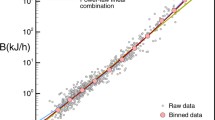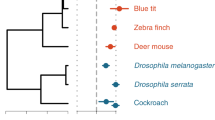Abstract
Allometry relations (ARs) in physiology are nearly two hundred years old. In general if X ij is a measure of the size of the i th member of a complex host network from species j and Y ij is a property of a complex subnetwork embedded within the host network an intraspecies AR exists between the two when Y ij = aX b ij . We emphasize that the reductionist models of AR interpret X ij and Y ij as dynamic variables, albeit the ARs themselves are explicitly time independent. On the other hand, the phenomenological models of AR are based on the statistical analysis of data and interpret 〈X i 〉 and 〈Y i 〉 as averages over an ensemble of individuals to yields the interspecies AR 〈Y i 〉 = a〈X i 〉b. Modern explanations of AR begin with the application of fractal geometry and fractal statistics to scaling phenomena. The detailed application of fractal geometry to the explanation of intraspecies ARs is a little over a decade old and although well received it has not been universally accepted. An alternate perspective is given by the interspecies AR based on linear regression analysis of fluctuating data sets. We emphasize that the intraspecies and interspecies ARs are not the same and show that the interspecies AR can only be derived from the intraspecies one for a narrow distribution of fluctuations. This condition is not satisfied by metabolic data as is shown separately for aviary and mammal data sets. The empirical distribution of metabolic allometry coefficients is shown herein to be Pareto in form. A number of reductionist arguments conclude that the allometry exponent is universal, however herein we derive a deterministic relation between the allometry exponent and the allometry coefficient using the fractional calculus. The co-variation relation violates the universality assumption. We conclude that the interspecies physiologic AR is entailed by the scaling behavior of the probability density, which is derived using the fractional probability calculus.
Similar content being viewed by others
References
R. Albert and A.-L. Barabasi, Statisitical mechanics of complex networks. Rev. Mod. Phys. 74 (2002), 47–97.
G. Aquino, M. Bolgona, P. Grigolini and B.J. West, Beyond the death of linear response: 1/f optimal information transport. Phys. Rev. Lett. 105 (2010), 069901–069905.
J.R. Banavar, J. Damuth, A. Maritan and A. Rinaldo, Ontogenetic growth: Modeling universality and scaling. Nature 420 (2002), 626–627.
W.W. Calder, III, Size, Function and Life History. Harvard University Press, Cambridge, MA (1984).
G. Cuvier, Recherches sur les ossemens fossils. Paris (1812).
P.S. Dodds, D.H. Rothman and J.S. Weitz, Re-examination of the “3/4-law” of Metabolism. J. Theor. Biol. 209 (2001), 9–27.
H.A. Feldman and T.A. McMahon, The 3/4 mass exponent for energy metabolism is not a statistical artifact. Resp. Physiol. 52 (1983), 149–163.
F. Galton, The geometric mean in vital and social statistics. Proc. R. Soc. London 29 (1879), 365–367.
P.D. Gingerich, Arithmetic or geometry normality of biological variation: An empiricial test of theory. J. Theor. Biol. 204 (2000), 201–221.
N.R. Glass, Discussion of calculation of power function with special reference to respiratory matabolism in fish. J. Fish Res. Board Can. 26 (1969), 2643–2650.
D.S. Glazier, Beyond the “3/4-power law”: Variation in the intra- and interspecific scaling of metabolic rate in animals. Biol. Rev. 80 (2005), 611–662.
D.S. Glazier, A unifying explanation for diverse metabolic scaling in animals and plants. Biol. Rev. 85 (2010), 111–138.
B.V. Gnedenko and A.N. Kolmogorov, Limit Distributions for Sums of Independent Random Variables. Transl. from Russian by Chung K.L., Addison-Wesley, Reading, MA (1954).
B.V. Gnedenko, The Theory of Probability. Transl. by B.D. Seckler, Chelsea Pub., New York (1962).
S.J. Gould, Allometry and size in ontogeny and phylogeny. Biol. Rev. Cam. Philos. Soc. 41 (1966), 587–640.
B.T. Grenfell, C.S. Williams, O.N. Bjornstad and J.R. Banavar, Simplifying biological complexity. Nature 21 (2006), 212–213.
J.H. Graham, K. Shumazu, J.E. Emien, D.C. Freeman and J. Merkel, Growth models and the expected distribution of fluctuating symmetry. Biol. J. Linn. Soc. 80 (2003), 57–65.
J.M. Hausdorff, P.L. Purdon, C.-K. Peng, Z. Ladin, J.Y. Wei and A.L. Goldberger, Fractal dynamics of human gait: Stability of long-range correlations. J. Appl. Physiol. 80 (1996), 1448–1457.
A.A. Heusner, Energy metabolism and body size: I. Is the 0.75 mass exponent of Kleiber’s equation a statistical artifact?. Resp. Physiol. 4, No 8 (1982), 1–12.
A.A. Heusner, Size and power in mammals. J. Exp. Biol. 160 (1991), 25–54.
J.S. Huxley, Problems of Relative Growth. Dial Press, New York (1931).
P. Kaitaniemi, How to derive biological information from the value of the normalization constant in allometric equations. PLoS ONE 3, No 4, e1932 (2008), 1–4.
A.J. Kerkhoff and B.J. Enquist, Multiplicative by nature: Why logarithmic transformation is necessary in allometry. J. Theor. Biol. 257 (2009), 519–521.
J. Klafter and R. Metzler, The random walk’s guide to anomalous diffusion: A fractional dynamics approach. Phys. Rept. 339 (2000), 1–77.
K. Lindenberg and B.J. West, The Nonequilibrium Statistical Mechanics of Open and Closed Systems. VCH, New York (1990).
E.N. Lorenz, Deterministic nonperiodic flow. J. Atmos. Sci. 20 (1963), 130–141.
E.N. Lorenz, The Essence of Chaos. University of Washington Press, Seattle (1993).
R.D. Manaster and S. Manaster, Techniques for estimating allometric equations. J. Morphol. 147 (1975), 299–308.
B.B. Mandelbrot, Fractals, Form and Chance. W.H. Freeman, San Francisco, CA (1977).
T.A. McMahon and J.T. Bonner, On Size and Life. Sci. Amer. Library, New York (1983).
B.K. McNab, Ecological factors affect the level and scaling of avian BMR. Comp. Biochem. Physiol. 152 (2009), 22–45.
P. Meakin, Fractals, Scaling and Growth Far From Equilibrium. Cambridge University Press, Cambridge, MA (1998).
E.W. Montroll and G. Weiss, Random walks on lattices, II. J. Math. Phys. 6 (1965), 167–181.
E.W. Montroll and B.J. West, On an enriched collection of stochastic processes. In: Fluctuation Phenomena, Eds. E.W. Montroll and J.L. Lebowitz, Studies in Statistical Mechanics, Vol. VII, North-Holland, Amsterdam (1979).
T.R. Nelson, B.J. West and A.L. Goldberger, The fractal lung: universal and species-related scaling patterns. Experientia 46 (1990), 251–254.
M.E.J. Newman, The structure and function of complex networks. SIAM Rev. 45 (2003), 167–256.
M.E.J. Newman, Power laws, Pareto distributions and Zipf’s law. Contemp. Phys. 46 (2005), 323–351.
E. Ott, Chaos in Dynamical Systems. Cambridge University Press, New York (1993).
G.C. Packard, On the use of logarithmic transformations in allometric analysis. J. Theor. Biol. 257 (2008), 515–518.
C.-K. Peng, J. Mistus, J.M. Hausdorff, S. Havlin, H.E. Stanley and A.L. Goldberger, Long-range anti-correlations and non-Gaussian behavior of the heartbeat. Phys. Rev. Lett. 70 (1993), 1343–1346.
R.H. Peters, The Ecological Implications of Body Size. Cambridge University Press, Cambridge (1983).
L.E. Reichl, A Modern Course in Statistical Physics. John Wiley & Sons, New York (1998).
M.J. Reiss, The Allometry of Growth and Reproduction. Cambridge University Press, Cambridge (1989).
G. Samorodnitsky and M.S. Taqqu, Stable Non-Gaussian Random Processes. Chapman & Hall, New York (1994).
V.M. Savage, J.P. Gillooly, W.H. Woodruff, G.B. West, A.P. Allen, B.J. Enquist and J.H. Brown, The predominance of quarter-power scaling biology. Func. Ecol. 18 (2004), 257–282.
K. Schmidt-Nielsen, Scaling, Why is Animal Size so Important?. Cambridge University Press, Cambridge (1984).
V. Seshadri and B.J. West, Fractal dimensionality of Lévy processes. Proc. Nat. Acad. Sci. USA 79 (1982), 4501–4505.
R.J. Smith, Logarithmic transformation bias in allometry. Amer. J. Phys. Anthropol. 90 (1993), 215–228.
C.F. Stevens, Darwin and Huxley revisited: The origin of allometry. J. Biol. 8 (2009), 14–21.
V.V. Uchaikin, Montroll-Weiss problem, fractional diffusion equations and stable distribution. Int. J. Theor. Phys. 39 (2000), 3805–3813.
D.I. Warton, I.J. Wright, D.S. Falster and M. Westoby, Bivariate line fitting methods for allometry. Biol. Rev. 85 (2006), 259–291.
D.J. Watts, Small Worlds. Princeton University Press, Princeton, N.J. (1999).
E.R. Weibel, Symmorphosis: On Form and Function in Shaping Life. Harvard University Press, Cambridge, MA (2000).
B.J. West and V. Seshadri, Linear systems with Lévy fluctuations. Physica A 113 (1982), 293–216.
B.J. West, V. Barghava and A.L. Goldberger, Beyond the principle of similitude: renormaization in the bronchial tree. J. Appl. Physiol. 60 (1986), 1089–1097.
B.J. West, Physiology, Promisucity and Prophecy at the Millennium: A Tale of Tails. Studies of Nonlinear Phenomena in Life Science: Vol. 7, World Scientific, Singapore (1999).
B.J. West, Where Medicine Went Wrong. Studies of Nonlinear Phenomena in Life Science: Vol. 11, World Scientific, Singapore (2006).
B.J. West, E.L. Geneston and P. Grigolini, Maximizing information exchange between complex networks. Phys. Rept. 468 (2008), 1–99.
B.J. West, Fractal physiology and the fractional calculus: a perspective. Front. Physiol. 1, No 12 (2010); doi: 10.3389/fphys.2010.00012, at http://www.ncbi.nlm.nih.gov/pmc/articles/PMC3059975/
B.J. West and D. West, Origin of allometry hypothesis. In: Fractional Dynamics: Recent Advances. J. Klafter, S.C. Lim, R. Metzler (Editors), World Sci. (2011), 375–390; at http://ebooks.worldscinet.com/ISBN/9789814340595/9789814340595.html
D. West and B.J. West, Are allometry and macroevolution related?. Physica A 390 (2011), 1733–1736.
D. West and B.J. West, Statistical origin of allometry. Europhys. Lett. 94 (2011), 38005-p1–p6.
B.J. West and P. Grigolini, Complex Webs: Anticipating the Improbable. Cambridge University Press, Cambridge (2011).
G.B. West, J.H. Brown and B.J. Enquist, A general model for the origin of allometric scaling laws in biology. Science 276 (1997), 122–124.
G.B. West, The origin of universal scaling laws in biology. Physica A 263 (1999), 104–113.
G.B. West, V.M. Savage, J. Gillooly, B.J. Enquist, W.H. Woodruff and J.H. Brown, Why does metabolic rate scale with body size?. Nature 421 (2003), 712–714.
C.R. White, P. Cassey and T.M. Blackburn, Metabolic allometry exponents are not universal. Ecology 88 (2007), 315–323.
J.H. Zar, Calculation and miscalculation of the allometric equation as a model in biological data. BioScience 18 (1968), 1118–1120.
V.M. Zolotarev, One-dimensional Stable Distributions. Transl. Math. Monographs 65, Amer. Math. Soc., Providence, RI (1986).
Author information
Authors and Affiliations
Corresponding author
About this article
Cite this article
West, B.J., West, D. Fractional dynamics of allometry. fcaa 15, 70–96 (2012). https://doi.org/10.2478/s13540-012-0006-3
Received:
Published:
Issue Date:
DOI: https://doi.org/10.2478/s13540-012-0006-3
MSC 2010
Key Words and Phrases
- allometry
- allometry coefficient
- allometry exponent
- fractal statistics
- co-variation
- Pareto distribution
- entropy
- self-similarity
- scaling
- fractal scaling
- universality
- fractional dynamics
- interspecies allometry relation
- intraspecies allometry relation
- fluctuations
- probability density
- data
- linear regression
- phenomenological distributions
- histogram
- inverse power law
- fractional probability
- fractional diffusion equation
- Lévy distribution
- Fokker-Planck equation
- renormalization group relation
- entropy balance
- networks




